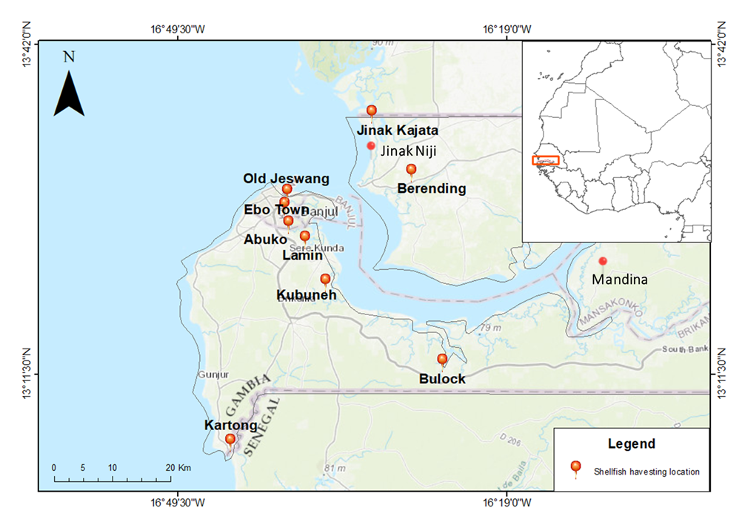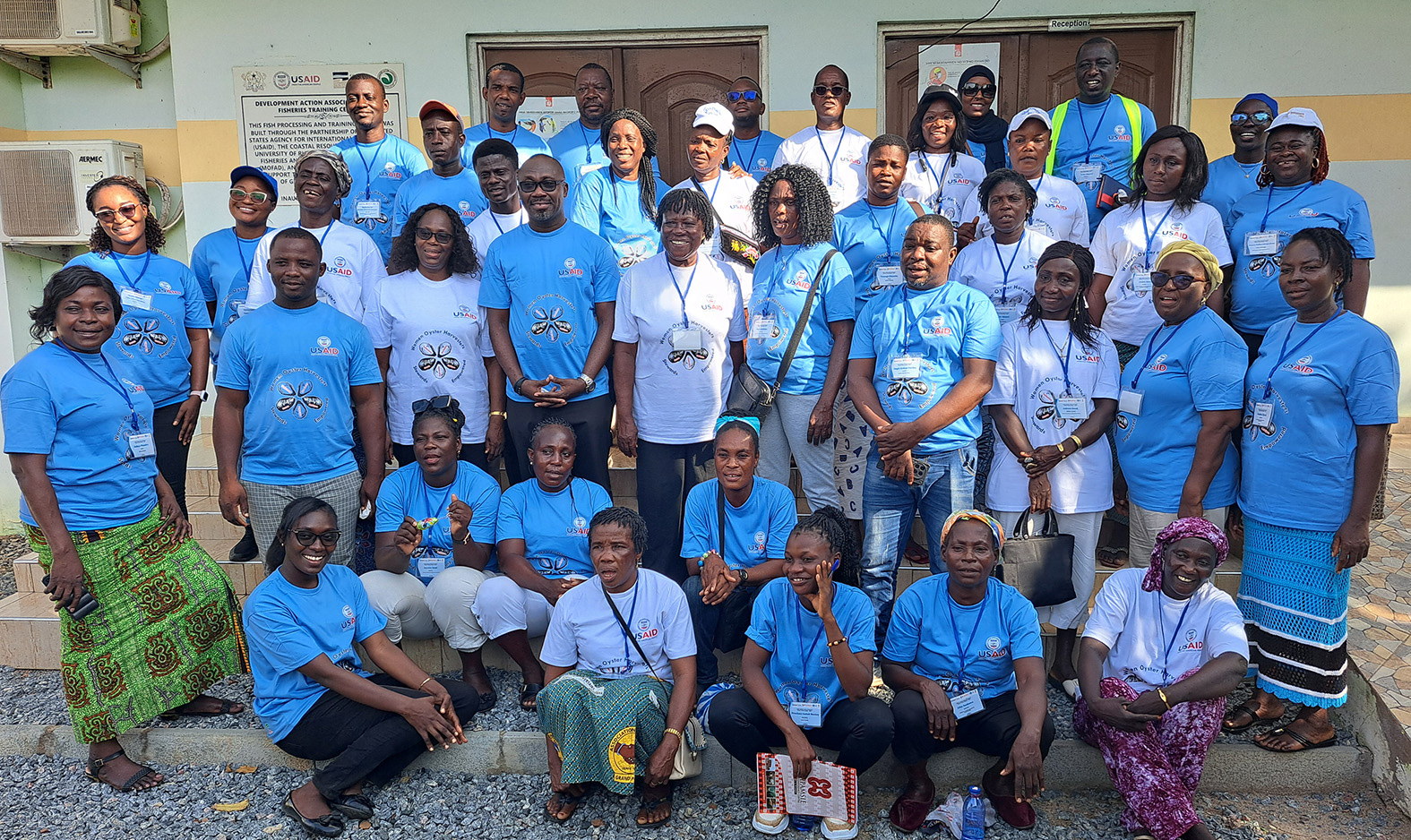Country
Profiles
Country
Networks
Country
Associations
The Gambia
Overview
The Gambia borders the Republic of Senegal and the Atlantic Ocean, with a coastline of about 80 km. Women dominate the shellfisheries (about 89% of shellfishers). Women and men are engaged in harvesting oysters, but cockles, crabs, and welk are exclusively harvested by women. The role of men in the oyster value chain ranges from shucking to boat repairs, offloading during landing, and helping in fuelwood hewing/fetching for processing.| Basic Contextual Information | |
|---|---|
|
Country
|
The Gambia
|
|
Total land area
|
11,295 km²
|
|
Population
|
2.28 million (2018)
|
|
Percentage population living in/near the coast
|
---
|
|
Gross Domestic Product (GDP)
|
1.633 billion USD (2018)
|
|
Human Development Index (HDI)
|
0.466 (174 out of 189)
|
|
Length of coastline
|
80 km
|
|
Fish consumption (as percent of animal protein)
|
40%
|
|
Anaemia prevalence
|
57.5% among women of reproductive age (15 - 49)
|
|
Estimated mangrove cover
|
59,717 ha (2016)
|
|
Estimated estuarine and mangrove ecosystem-based shellfish harvesters
|
2,042
|
|
Estimated women shellfish harvesters (percent)
|
1,817+ (89%+)
|
|
Estimated direct household beneficiaries
|
26,199
|
|
Number of coastal systems with mangrove-based shellfishing
|
4 (Tanbi, Niumi, Baobolong, Alahein)
|
|
Shellfish management regulations
|
Oyster and Cockle FIsheries Co-Management Plan for the Tanbi Wetlands Complex
|
|
Mangrove management regulations
|
---
|
|
Coastal ecosystems with shellfisheries identified in Ramsar sites
|
Tanbi Wetland National Park (TWNP) (2007) (6400 ha); Niumi National Park (2008) and Management plan 2011 (4,940 ha); Baobolon Wetland Reserve (1996) (20,000 ha)
|
Women shellfishers are largely concentrated within the 6,304-hectare Tanbi Wetland Complex, where there is a Cockle and Oyster Fishery Co-Management Plan for the Tanbi Special Management Area developed with the support of the USAID/BaNafa project and gazetted in 2013. This plan delegates exclusive use rights to the oyster and cockle fishery in the Tanbi to the TRY Oyster Women’s Association. Other shellfishery areas include the Alahein River Estuary on the border with Southern Senegal and mangrove ecosystems in the Niumi National Park on the North Bank, as well as Gambia River estuarine mangrove ecosystems further up the river (i.e., Bullock and Bintang). Although the co-management plan has an annual 8-month closed season and other measures, excessive harvesting during the open season has been prevalent over the years in Tanbi and Alahein. There are no daily harvest quotas set, harvesting is not monitored, and the number of harvesters continually increases with no plans to reduce the harvesting effort. This has resulted in a decline in stocks and the migration of some harvesters to other less populated oyster harvesting sites without overexploitation. The lack of monitoring in The Gambia’s shellfisheries raises concern as there is no evidence to determine whether harvest strategies are sustainable, and there are no harvest control rules.

All resource users interviewed in a study on estuarine and mangrove ecosystem-based shellfisheries in The Gambia were engaged in harvesting, processing, trading, and consumption. About 98% of the total number of shellfishers estimated in each community (98% were female) were said to engage in harvesting, processing, trading, and consumption. This indicates a highly vertically integrated value chain with women harvesters dominating almost exclusively at every node. This implies that value chain improvements at any node can directly benefit women harvesters and create an opportunity to incentivize behaviour change for sustainable resource management.
Oyster catch value per harvester operating within the Tanbi Wetland Complex is much higher than that of those operating in the hinterland. A cup of oyster meat (63 grams) within the Tanbi costs fifty Gambian dalasi (D50.00), approximately one US dollar (US $1.00). In contrast, a cup of oyster meat costs D30.00, approximately US 00.60 cents in the hinterland. Cockle harvesting is dominantly undertaken within the Alahein River estuary, specifically in Kartong, where catch value is estimated between US dollars, $5.00 and $15.00 per person daily. Shellfishers in The Gambia face challenges such as reduced catches, reduced income, unhygienic conditions of work at landing sites, lack of value addition, and limited capacity building on management, conservation, and financial management.
Recommendations for actions for improvement of shellfisheries in Th Gambia include;
Strengthen associations on organisational management and support informal ones to become formal. Create awareness on the legal instruments mentioned in the report.
Review existing or former family oyster culture outcomes and recommend more profitable and sustainable ventures.
Train shellfishers in financial management, hygiene, and sanitation.
Re-introduce credit and savings previously undertaken based on lessons learned as there was a lack of trust coupled with lack of knowledge on financial management reported by members.
Strengthen the 8-month closed season.
Support sustainable, diversified, and alternative livelihoods.
Strengthen the seasonal shellfish closure enforcement and other regulations to ensure compliance by shellfishers, fishermen, and commercial mangrove dealers.
Empower shellfish harvesters to take control of shellfish and mangrove stewardship within their communities through co-management plans.
Expand the oyster and cockle co-management plan to cover all shellfish landing sites and add other shellfish to the co-management plan.
Promote annual mangrove regeneration and restoration.
Train residents along mangrove areas on water quality management.
Support construction of shellfish markets and provide preservation facilities to reduce post-harvest losses and selling at low prices.
Develop a communication plan under this project to facilitate networking and skills transfer.
Organize study tours locally and externally between project beneficiary countries.
Shellfish Association
Reports
-
-
The Estuarine and Mangrove Ecosystem-Based Shellfisheries of West Africa: Spotlighting Women-Led Fisheries LivelihoodsView Technical Report
-
Participatory Assessment of Shellfisheries in the Estuarine and Mangrove Ecosystems of The GambiaView Technical Report
-
Literature Review for the Participatory Regional Assessment of the Shellfisheries in 11 Countries from Senegal to NigeriaView Technical Report
-
Oyster Shellfisheries Locations in Ghana and The GambiaView Technical Report
-
West Africa Women-led Shellfisheries Co-Management in a Global Context: Case Studies From Africa, Asia, and South AmericaView Technical Report
-
Site Based Assessment of Oyster Shellfisheries and Biophysical Conditions in Ghana and The GambiaView Technical Report
-
Mangrove Conservation and Restoration Sites Mapping in Ghana and The GambiaView Technical Report
-
Developing Community Action Plans for Mangroves Co-Management in Ghana and The GambiaView Technical Report
-
Report on Establishment of Oyster Aquaculture in Lamin, GambiaView Technical Report
-
A review of mangrove and forestry co-management in Ghana and The GambiaView Technical Report
-
Multi-stakeholder review of mangrove restoration initiatives to improve biodiversity in Ghana and The GambiaView Technical Report
-
Value Chain and Economic Analysis of the Shell By- Product of Bivalve Fisheries in Ghana and The Gambia: An Assessment of Oyster, Cockle, and Clam ShellsView Technical Report
-
Multivariate Analysis of the Theory of Change ModelView Technical Report
-
Drivers and Threats Affecting Mangrove Forest Dynamics in Ghana and The GambiaView Technical Report
-
Landscape Visioning in Tanbi, Bulock, and Allahein Sites, The GambiaView Technical Report
-
Technical Report on Site Based Research in Ghana and The GambiaLand-seascape Food and Nutrition ProfilesView Technical Report
-
Dietary Intakes, Food Security and Anemia Prevalence Among Women Shellfishers in Selected Estuary Sites in Ghana and The GambiaView Technical Report
-
Publications
-
-
Spotlighting Women-Led Fisheries Livelihoods Toward Sustainable Coastal Governance: The Estuarine and Mangrove Ecosystem Shellfisheries of West AfricaView Peer-reviewed Article
-
Mangrove ecosystems mapping in parts of Ghana and The Gambia for sustainable regeneration and utilizationView Peer-reviewed Article
-
Presentations
-
No Presentations
Get started by creating a new presentation.
News, Stories & Conversations


